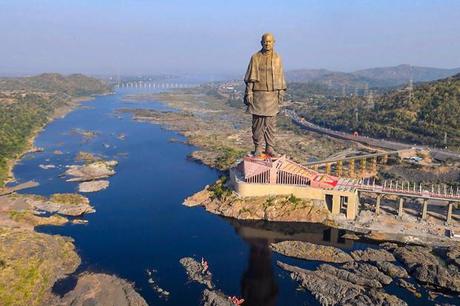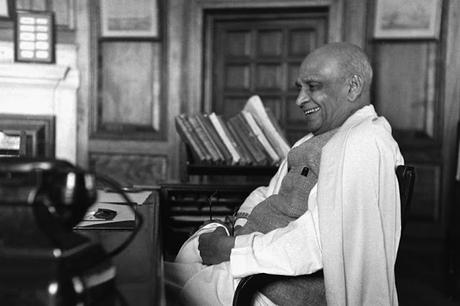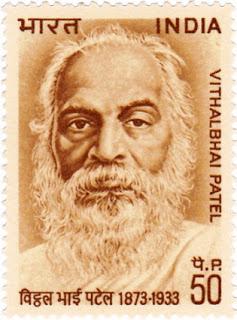Away from IPL - Test no. 483 played at Kanpur in Dec 1959 was significant !
The Sardar Sarovar project was a vision of the first deputy prime minister of India, Sardar Vallabhbhai Patel. The foundation stone of the project was laid out by Pandit Jawaharlal Nehru after carrying out a study on the usage of the Narmada river water that flowed through the states of Madhya Pradesh and Gujarat and into the Arabian Sea. A project report prepared for the dam led to much dispute over the means of distributing the Narmada water among the three states- Gujarat, Maharashtra and Madhya Pradesh. As the negotiations bore no fruit, a Narmada Water Dispute Tribunal (NWDT) was created in 1969 to decide the fate of the project. The construction for dam begun in 1987, but the project was stalled by the Supreme Court of India in 1995 in the backdrop of Narmada Bachao Andolan. In 2000–01 the project was revived but with a lower height of 110.64 metres under directions from SC, which was later increased in 2006 to 121.92 meters and 138.98 meters in 2017. The water level in the Sardar Sarovar Dam at Kevadia in Narmada district reached its highest capacity at 138.68 metres on 15 September 2019. The man, real visionary and tall leader ..

He was the Man instrumental in the creation of the All India Services which he described as the country's "Steel Frame". In his address to the probationers of these services, he asked them to be guided by the spirit of service in day-to-day administration. He reminded them that the ICS was no-longer neither Imperial, nor civil, nor imbued with any spirit of service after Independence. He, more than anyone else in post-independence India, realised the crucial role that civil services play in administering a country, in not merely maintaining law and order, but running the institutions that provide the binding cement to a society.
Rashtriya Ekta Diwas (National Unity Day) was introduced by the Government of India and inaugurated by Respected Prime Minister Shri Narendra Modiji in 2014. The intent is to pay tribute to Patel, who was instrumental in keeping India united. It is celebrated on 31 October every year as annual commemoration of the birthday of the Iron Man of India Sardar Vallabhbhai Patel, one of the founding leaders of Republic of India. National Unity Day celebrates the birthday of Patel because, during his term as Home Minister of India, he is credited for the integration of over 550 independent princely states into India from 1947 to 1949 by Independence Act (1947). He is known as the "Bismarck of India”.
Vallabhbhai Jhaverbhai Patel [31.10.1875 – 15.12.1950), popularly known as Sardar Patel, served as the first Deputy Prime Minister of India. He was an Indian barrister, and a senior leader of the Indian National Congress who played a leading role in the country's struggle for independence and guided its integration into a united, independent nation. Patel was born in Nadiad District Kheda and raised in the countryside of the state of Gujarat. He was a successful lawyer. He subsequently organised peasants from Kheda, Borsad, and Bardoli in Gujarat in non-violent civil disobedience against the British Raj, becoming one of the most influential leaders in Gujarat. He was appointed as the 49th President of Indian National Congress, organising the party for elections in 1934 and 1937 while promoting the Quit India Movement.

As the first Home Minister and Deputy Prime Minister of India, Patel organised relief efforts for refugees fleeing to Punjab and Delhi from Pakistan and worked to restore peace. He led the task of forging a united India, successfully integrating into the newly independent nation those British colonial provinces that had been "allocated" to India.
In Gujarat, now a statue stands tall remembering him. The world’s tallest statue of Sardar Vallabhai Patel, fondly called - the Statue of Unity, India has added another destination to visit among the thousands already present in the country. The 600-foot-tall statue is located in the Narmada district of Gujarat and is three-and-a half kilometres away from Kevadia town and about 200 km from Ahmedabad. The statue now adds to the growing list of tourism spots in Gujarat, which already consists of the Great Rann of Kutch and the Gandhi circuit which are big attractions. The statue is twice the size of the Statue of Liberty in New York ; Visitors can reach up to the observational deck, located at 400 feet high, which is more than half of the statue.
The idea was not born in a day ~ back in 2013, when Modiji was the CM of Gujarat, he is known to have kept a small-scale prototype of the proposed statue on the desk in his office. When hosting foreign dignitaries in the office, he would spend considerable time explaining the significance of the grand project. He even gifted small replicas to some of them. The dream is a reality. Iconography is not only an art but also intrinsic to politics. He made sure that people of India were with him in this ambitious initiative. He persuaded the people across the country to emotionally invest in the building of the statue.
More than the statues, dynasty is killing Indian democracy and politics. Every political observer knows that most parties distribute tickets in elections to the clan of erstwhile leaders – that way the sons and daughters walk over the party cadre. An example is Nehru family – Motilal Nehru served as Congress President and his son Jawaharlal Nehru was chosen by Gandhi to becoming the first Prime Minister of India. Vijaya Lakshmi Pandit, eldest daughter of Motilal Nehru, represented India in UN General assembly. Brijlal Nehru, son of Nandlal Nehru and a nephew of Motilal Nehru, was the Finance Minister of the princely state of Jammu and Kashmir during the rule of Maharaja Hari Singh. Indira Gandhi became the the first woman Prime Minister of India. Her husband was earlier MP. Brajkumar Nehru, son of Brijlal, served as Governor. Arun Nehru, great grand son of Nandlal Nehru was a union minister during the 1980s. Rajiv Gandhi became the 7th PM of India. Sanjay Gandhi dazzled in politics before untimely death. Sonia Gandhi, is President of Indian National Congress and MP; Maneka Gandhi serves as the Indian Union Cabinet Minister for Women & Child Development; Rahul Gandhi is being projected to be the leader; Priyanka, Robert Vadra – all are in politics.
In 1967 Kappal Ottiya thamizhan VO Chidambaram’s Pillai contestedfrom Ottapidaram but was defeated – the political parties did not support him !.. .. Patel’s family too tried to dangle with politics.Sardar Patel’s four family members fought elections: son Dahyabhai, daughter Maniben, daughter-in-law Bhanumati and her businessman-brother Pashabhai Patel. Dahyabhai Patel was a Congressman and an elected member of the Bombay Municipal Corporation in 1939, when Sardar Patel was still around. He spent 18 years at the corporation, out of which he was a leader of the Congress party for six years.By his own account, when he was all set to fight the 1957 Lok Sabha election as a Congress candidate, Nehru was not willing to acknowledge Sardar Patel’s contribution and it became all too apparent at the annual session of Congress in January 1957 Dahyabhai left the Congress and was later elected to Rajya Sabha in 1958 as nominee of Maha Gujarat Janta Parishad.Interestingly Dahyabhai was an insurance man, employed by the Oriental Insurance Company.

Otto Eduard Leopold, Prince of Bismarck, Duke of Lauenburg (1815 – 1898) was a conservative German statesman who masterminded the unification of Germany in 1871 and served as its first chancellor until 1890, in which capacity he dominated European affairs for two decades. He had previously been Minister President of Prussia (1862–1890) and Chancellor of the North German Confederation (1867–1871). Following the victory against Austria, he abolished the supranational German Confederation and instead formed the North German Confederation as the first German national state, aligning the smaller North German states behind Prussia.
Prime Minister Narendra Modi has o inaugurated Sardar Patel Zoological Park, popularly known as Jungle Safari, in Kevadia, Gujarat's Narmada district. Sardar Patel Zoological has been set up near the 182-metre Statue of Unity. The zoo houses wild animals and birds brought from all over the world. Kevadiya, a small town with a population of 6,788 people and just 3.5 km from the Statue of Unity in Gujarat, is growing, has its own railway station, which would be a Green certified one.
Concluding in a lighter vein, at Kanpur in 1959, India tasted its maiden Test victory against Australia and the hero was a Patel. Off-spinner Jasu Patel in that 2nd test against Richie Benaud’s Aussies took 14 wickets. His 9 for 69 was India's best Test bowling figures till it was overtaken by Anil Kumble nearly 40 years later. There have been some more Patels as well in Cricket – the names that readily comes to my mind are : Brijesh Patel, Ashok Patel, Munaf Patel, Rashid Patel, Parthiv Patel, Axar Patel, Dipak Patel (NZ), Jeetan Patel (NZ); Samit Patel (Eng)
With regards – S. Sampathkumar31.10.2020.

